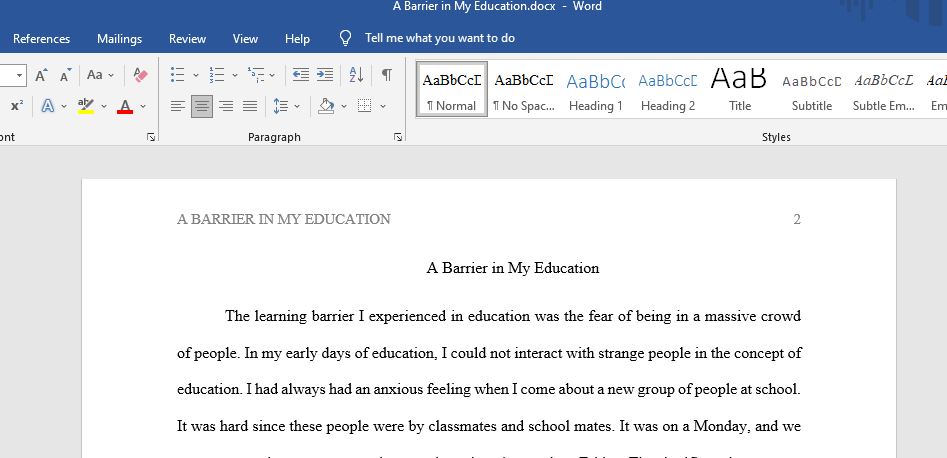Writing a Paragraph: A Barrier in My Education
OVERVIEW:
Write a 300 – word narrative paragraph about a specific barrier or border that had an important influence on your education. The experience you choose should be one that you struggled to overcome or taught you a lesson. It could be an external barrier such as an experience with a teacher or poverty or an internal barrier such as a learning disability. Think about the experiences the student in First Generation faced. The experience may have helped you form a belief, change a belief, or strengthen your belief about education. You should describe the experience, reflecting on what happened as you tell of its effects.
NOTE: Please keep in mind that in this assignment, you should discuss ONE SPECIFIC barrier that you had. This paragraph should tell your reader about one experience, one day, one moment, which had a defining impact on your education. It should be a story, with a beginning, middle, and end.
GUIDELINES:
This should be at least 300 words in length, double spaced, and typed in a 12pt font (Times New Roman).
DEFINITIONS:
This assignment may still be unclear. Here are some definitions to help clarify this assignment:
In a narrative, you recount an event or story in order to explain some insight or truth gained from an experience. The writer who narrates tells a story to make a point—your first trip alone, the passing of a family member, a fight with a parent. An expository narrative has a point, a lesson, or a message to impart to the reader through telling a story or recounting an event and framing it with analysis.
When you want to explain what happened, you will need to tell the story in some kind of chronological order, putting the most important events—I took the wrong turn, I entered the funeral parlor, she yelled at me—in the most prominent position. When you want to give the texture of the experience, you will need to select words and images that help your readers see, hear, and feel what happened, sensory details—the road snaked to a dead end, the crowd thundered into applause, the sunshine softened our scowls. When you show and tell in this way, you can help your readers see the meaning of the experience you want to convey.
It is the inclusion of a lesson that distinguishes the expository narrative essay from merely narrative description of events. Expository narrative essays feature a lesson or clear message that is shown to the reader through the recounting of events or information. This analytical purpose is stated in the thesis statement in the beginning of the essay. The lesson or message is then supported/explained/proved/demonstrated in the body paragraphs. It is finally restated in the conclusion of the experience.
For our purposes in this paragraph, the message or lesson is the takeaway or analysis you have about the barrier event. Put it into context for your audience. Why is this important? What makes this barrier significant to you? To your educational journey? Why is this barrier an important one to share with your audience?
PARAGRAPH STRUCTURE:
Please follow the PIE paragraph structure you learned about this week. Feel free to use this Sample PIE Paragraph as a guide. In your paragraph, please include:
as a guide. In your paragraph, please include:
- Topic sentence: Identifies what you are trying to explain, show, prove, or argue in your narrative. States what your barrier is or the barrier you are going to focus on. States the lesson or meaning you will impart to the reader about that barrier/experience. It is arguable.
- Information: Develop the narration of the one event using time order. The informative section of your paragraph should include specific details of the event, including who was involved, what happened, where it happened, and when it happened. This portion of the paragraph will include the sensory details. Remember to be as specific and vivid as possible.
- Explanation: The explanation portion of the paragraphs will explain what you were thinking and feeling as the events took place and will tie the information back to the topic sentence. Re-emphasizes the lesson learned and the message of the story you’ve told in your narrative.
Answer preview:

word limit:312
